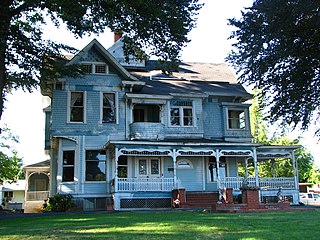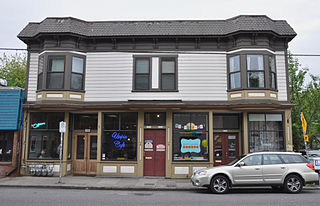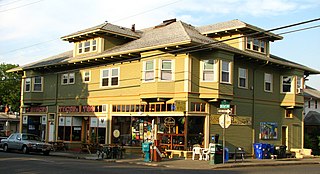Eastmoreland is an early-twentieth century, tree-filled neighborhood in inner southeast Portland, Oregon, United States. Eastmoreland was named for a local real estate developer, Judge J.C. Moreland.

The Genoa Building, at the intersection of Southeast Belmont Street and Southeast 29th Avenue in Portland in the U.S. state of Oregon, is a single-story commercial building listed on the National Register of Historic Places. Built in a Vernacular style with Mediterranean features in 1930, it was added to the register in 1997.

The Thomas Graham Building, 6031 Southeast Stark Street, Portland, in the U.S. state of Oregon, is a two-story commercial building listed on the National Register of Historic Places. Built in 1910, it was added to the register in 1992.

The William E. Brainard House is a historic house in Portland, Oregon, United States. The Mount Tabor neighborhood was one of Portland's prestigious residential districts in the late 19th century, and this 1888 Italianate structure is one of the few stately homes remaining from that period. It was occupied by a series of residents prominent in business, including farmer, real estate investor, and banker William E. Brainard; stock broker and investment banker George W. Davis; and dentist and dental supplier John C. Welch.

The Monastery of the Precious Blood is a building in southeast Portland, Oregon, United States, listed on the National Register of Historic Places. It is in the Montavilla neighborhood.

The William B. Holden House is a house located in southeast Portland, Oregon listed on the National Register of Historic Places. The property was deemed significant for its architecture, for its landscape architecture, and for its association with the life of Dr. W. B. Holden (1873–1955). The house was designed by architect Roscoe Hememway. The landscape architecture was designed by John Alexander Grant. The property included a rose garden.

The Paul C. Murphy House is a 2.5-story residence in southeast Portland, in the U.S. state of Oregon. Built in 1916 in the English Cottage style, it was added to the National Register of Historic Places in 1991.

The John Mock House is a house located in north Portland, Oregon, listed on the National Register of Historic Places. The Queen Anne style home constructed in 1894 was commissioned by John Mock, who owned much of the property in what is now the University Park neighborhood of Portland. The home was built as a replacement to Mock's original log cabin, which burnt in 1889. Mock died in the home at the age of 78. It sits next to Columbia Park Annex.

The Nathaniel West Buildings in southeast Portland, Oregon, United States, are listed on the National Register of Historic Places. The two structures are part of a group of three, including West's Block, built by West in the late 19th century.

The Italian Gardeners and Ranchers Association Market Building, also known as the Italian Market, in southeast Portland, Oregon in the U.S. is a two-story commercial structure listed on the National Register of Historic Places. Built of concrete in 1922, it was added to the register in 1989.

Historic Portland Fire Station No. 23 in southeast Portland in the U.S. state of Oregon is a two-story structure listed on the National Register of Historic Places. Built in Italianate style in 1913, it was added to the register in 1989.

The F. M. Knight Building in southeast Portland in the U.S. state of Oregon is a two-story general commercial building listed on the National Register of Historic Places. Built in an Italianate style in about 1890, it was added to the register in 1989.

The Louis J. Bader House and Garden in southeast Portland in the U.S. state of Oregon is a 2.5-story single dwelling and garden listed on the National Register of Historic Places. Built in Tudor Revival style in 1922, it was added to the register in 1989.

The Henry Kuehle Investment Property, also known as the Gottsacker Grocery Building, in southeast Portland in the U.S. state of Oregon is a two-story commercial building listed on the National Register of Historic Places. Built in Bungalow/Craftsman style in 1909, it was added to the register in 1989.

Portland Fire Station No. 7, located in southeast Portland in the U.S. state of Oregon, is a two-story structure listed on the National Register of Historic Places. Built in 1927, it was added to the register in 1989. It was the last of numerous Portland firehouses to be designed by fire chief and architect Lee Gray Holden, who died of a stroke while visiting the No. 7 firehouse in 1943. The building continued to be used by the city's Fire Department until the 1980s, when it was sold off and used as an automobile garage. It was acquired by a local developer in 2009, and was restored and remodeled for office and retail use.

Oaks Pioneer Church, formerly known as St. John's Episcopal Church, in southeast Portland in the U.S. state of Oregon is a non-denominational one-story chapel listed on the National Register of Historic Places. Built in 1851, it was added to the register in 1974. It is the oldest intact church building in Oregon.

The Alfred Webb Investment Properties in southeast Portland in the U.S. state of Oregon consists of four Queen Anne cottages listed on the National Register of Historic Places. Built in 1891, they were added to the register in 1989.

The Alphabet Historic District, is a historic district in the Northwest District of Portland, Oregon which was listed on the National Register of Historic Places in 2000. It is 156.9 acres (63.5 ha) in area and includes 478 contributing buildings. It is roughly bounded by NW Lovejoy St., NW Marshall St., NW 17th Ave., W. Burnside St., and NW 24th Ave.



















